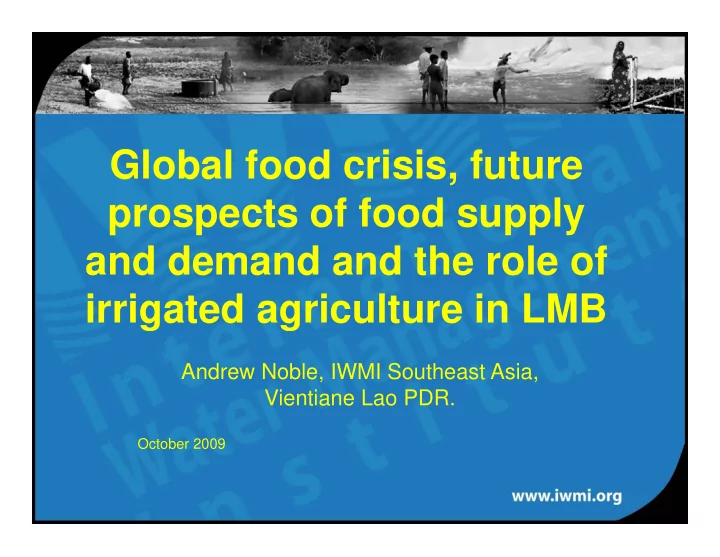

Global food crisis future Global food crisis, future prospects of food supply and demand and the role of irrigated agriculture in LMB irrigated agriculture in LMB Andrew Noble, IWMI Southeast Asia, Vientiane Lao PDR. October 2009
Outline • The food crisis. • Growth in agricultural output in the region. output in the region. • Role of irrigation in meeting future food meeting future food demands.
1. The food crisis 260 • Factors contributing • Factors contributing Food Price Index Food Price Index 240 240 Meat Price Index to the crisis: Dairy Price Index 220 Cereal Price Index Sugar Price Index – Conversion of 200 cropland to Biofuels; cropland to Biofuels; x 180 180 Price Inde – Higher oil prices; 160 – Low grain reserves; 140 – Market speculation; Market speculation; 120 120 – Extreme weather 100 events; 80 – Population growth. – Population growth 60 60 1990 1995 2000 2005 2010 Year FAOSTAT 2009
1. Changing in diets • Great income changes diets g and demand on water • Between 2 000 and 5 000 liters per person per Between 2,000 and 5,000 liters per person per day – depending on type and amount of food eaten and how it is produced Developing Developed
1. Impact of the food crisis • Restrictions on grain g exports by key countries. • Dramatic increases Dramatic increases in food prices - lower access to food food. • A further 110 million people into poverty and 44 million into and 44 million into the category of malnourished.
1. The future: drivers, risks , � Population growth and demographic change � Global economic conditions � Decreased investment for 5-10 � Decreased investment for 5 10 years � Return of urban workers to rural areas areas � Slowing export growth � Political instability � Climate change Climate change � Water resource development
2. Agriculture in the region. g cu u e e eg o � Food production has more than kept pace with population growth population growth � Diversification to meet changed demands � Food poverty decreasing � Export growth Export growth � Flexible production systems with rapid uptake of new crops and technologies, responsive to market signals � Expansion of agricultural areas is slowing – production gains from increased yields, intensification � Contribution to GDP � Contribution to GDP � livelihood for poor � growth in agriculture benefits poorest half of population
Rice production per capita 0.6 0.6 Cambodia es/capita 2. Increased 0.4 Lao PDR tonne M Myanmar food security Thailand 0.2 Vietnam 0 Global Hunger Index 1990 1992 1994 1996 1998 2000 2002 2004 2006 Source: FAOSTAT 35 30 25 20 1990 15 15 2008 10 5 0 0 Cambodia China Lao PDR Myanmar Thailand VietNam Source: FASTAT
2. Agriculture’s role in poverty alleviation alleviation Incidence of poverty: Southern Lao PDR Mekong corridor – e o g co do access to irrigation Lao PDR Bolovens Plateau – Bolovens Plateau – diverse cropping, Thailand commercial crops – coffee coffee Cambodia Socio-Economic Atlas of Lao PDR, , 2008
3. Global irrigation expansion 1960-2008 ?
3. Irrigation Projects LMB • Irrigation development in Northeast Thailand dominated Northeast Thailand dominated by small systems. • Little if any room for Littl if f expansion in Northeast Thailand. • Vietnam delta region fully developed developed. • Irrigation expansion possible in Lao PDR and Cambodia in Lao PDR and Cambodia.
3. Irrigation in the Delta • Deltas of the region are the rice bowls of the region. • 90% of Mekong delta rice 90% of Mekong delta rice destined for global markets. • The deltas are under stress: – Urbanization – Seawater intrusion and sea S level rise. – Ecosystem degradation – Over abstraction of groundwater. – Sediment deposition. • There is a need to produce 8 to 10 million tons rice to 10 million tons rice annually over the next 20 years to meet increased demand.
3. Revitalizing irrigation g g • Modernize yesteryear’s schemes for tomorrow’s y y needs. – Redesign, operate and manage large schemes for a range of uses. g • Support farmer initiatives. – Local adapted irrigation technologies i.e. wastewater, groundwater and scavenging surface water groundwater and scavenging surface water. • Look beyond conventional PIM/IMT recipes – Create public/private partnerships in the delivery of water services. t i • Expand capacity and knowledge
3. Key Messages on Irrigation � Water is the key to addressing food g security (FS). � Diversification of production systems is essential to meeting g FS. � Potential role of ‘new’ water for dry season irrigation in Lao PDR g and Cambodia.
4. Key Messages on Irrigation � Groundwater may be essential in meeting future FS – potential is unknown. � On-farm storage or tube wells offer greater flexibility for farmers. � Increase water use efficiency through multiple use systems.
THANK YOU
Recommend
More recommend